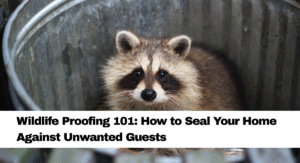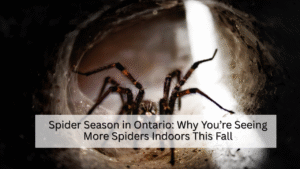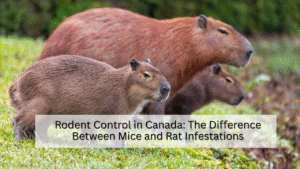It’s late at night, and you hear scratching in the attic. Maybe a faint rustle in the walls or a thud on the roof.
If that sounds familiar, you might not be alone in your own home.
Across Ontario, raccoons, squirrels, mice, and even skunks are constantly looking for warm, dry shelter, especially when the temperature drops.
Your attic, garage, or crawl space might be the perfect place for them to settle in.
Here’s the good news: with a little attention and the right prevention steps, you can stop wildlife from getting inside before it becomes a costly problem.
Let’s walk through what wildlife proofing really means, where to look for weak spots, and how to protect your home safely and humanely.

What Wildlife Proofing Really Means
Wildlife proofing isn’t about trapping animals. It’s about making your home less appealing to them in the first place.
Think of it as animal-proof renovation. You’re closing off entry points, securing food sources, and removing nesting spots.
Once these changes are made, raccoons, squirrels, and rodents will simply move on, looking for easier targets.
The goal isn’t to harm animals. It’s to build barriers that send a clear message: not here.
Why Wildlife Enters Homes
Wildlife doesn’t invade for fun. It’s about survival.
Ontario winters can be harsh, and animals look for the same things humans do: warmth, safety, and food.
Here’s what attracts them:
- Warm attics for nesting
- Garbage or compost bins for easy meals
- Open chimneys or vents for shelter
- Pet food left outdoors
- Unsealed gaps around the roof or foundation
If your home offers any of these, wildlife will take notice.
The Most Common Unwanted Guests in Ontario
Understanding who you’re dealing with helps you know where to look.
1. Raccoons
Strong, smart, and surprisingly dexterous.
They open bins, lift shingles, and can climb nearly any surface. They love attics and chimneys.
2. Squirrels
Small but destructive.
They chew through wood, vents, and insulation to build nests, often leaving droppings behind.
3. Mice and Rats
Experts at squeezing through tiny gaps.
Once inside, they chew wires, contaminate food, and reproduce quickly.
4. Skunks
Usually found under decks, porches, or sheds.
They dig burrows and spray when threatened, leaving an unforgettable odor.
5. Birds and Bats
They often nest in vents, chimneys, or rafters.
Bird droppings can corrode surfaces and spread disease.
Each of these animals has its own habits, but they all share one weakness: they depend on entry points we leave open.
Where Wildlife Gets In and How to Find It
You don’t need fancy tools to spot entry points—just a flashlight and patience.
Walk around your home and check these areas closely:
- Rooflines and Eaves
Look for gaps under shingles or loose soffits. Raccoons and squirrels often pry these open. - Attic Vents and Chimneys
Uncapped vents and chimneys are open invitations. You might even spot nesting material poking out. - Gaps Around Pipes and Utility Lines
Mice and rats use small cracks where wires or plumbing enter the house. - Foundations and Crawl Spaces
Check for small holes, cracks, or signs of digging near decks or sheds. Skunks love these areas. - Doors and Windows
Broken screens or gaps in weather stripping give easy access to insects and small rodents.
A quick inspection once or twice a year, especially before winter, can make a huge difference.
Simple Fixes That Go a Long Way
Wildlife proofing doesn’t have to be complicated or expensive.
Here are some practical, do-it-yourself solutions that make your home less vulnerable:
- Seal Gaps and Holes
Use steel mesh, hardware cloth, or caulk to seal holes.
Avoid foam alone, as rodents can chew right through it. - Cap Chimneys and Vents
Install metal or wire mesh covers to block entry while keeping airflow.
Make sure they’re secured tightly so raccoons can’t pull them off. - Reinforce Soffits and Roof Edges
Loose soffits or shingles are common entry points. Screw them down or replace damaged pieces. - Close Off Decks and Sheds
Use lattice or wire mesh around the base of decks and sheds, buried a few inches underground to stop digging. - Secure Garbage Bins
Raccoons are notorious bin raiders. Use tight-fitting lids and store bins in a shed or garage if possible. - Keep Pet Food Indoors
Outdoor pet dishes attract everything from skunks to rats. Feed pets inside and clean up spills right away.
These small steps create a barrier that most wildlife won’t bother to fight.
The Importance of Cleaning and Yard Maintenance
Even if your home is sealed, a messy yard can still attract wildlife.
Here’s how to keep it less inviting:
- Trim tree branches away from the roof.
- Clean up fallen fruit, nuts, or birdseed.
- Rake leaves and remove wood piles or junk that can serve as shelter.
- Store firewood at least 12 inches off the ground and 20 feet from your house.
Clean yards send a simple signal: no easy food, no easy shelter.
Wildlife-Proofing Mistakes to Avoid
A few common errors can undo all your hard work:
- Blocking holes while animals are inside.
This traps them, leading to damage, odor, and legal issues. Always check for activity before sealing. - Using traps without sealing entries.
Even if you remove one animal, others will move in if the space stays open. - Ignoring small signs.
Chewed wood, droppings, or faint scratching sounds can all indicate a growing problem. - Skipping seasonal checks.
Animals find new weak spots over time, especially after storms or roof repairs.
Wildlife proofing isn’t one and done; it’s ongoing maintenance.
When to Call a Professional
If you suspect animals are already inside or you’ve tried sealing but they keep coming back, it’s time for expert help.
A trained technician can find hidden access points you might miss and use humane removal methods that comply with Ontario wildlife laws.
At BugManagers, we specialize in humane wildlife removal and exclusion services across Ontario.
Here’s what that means for you:
- We inspect your property from roof to foundation.
- Identify every active and potential entry point.
- Remove animals safely using one-way doors or live traps.
- Seal and reinforce vulnerable areas permanently.
- Clean and sanitize affected spaces.
We don’t just fix the current issue; we prevent the next one.
Why Humane Removal Matters
Ontario law protects most wildlife species. That means trapping or relocating animals without a permit can be illegal and unsafe.
Humane removal focuses on letting animals leave naturally.
For example, one-way doors let raccoons or squirrels exit but not re-enter. Once they’re gone, the entry point is sealed.
This approach keeps animals safe, prevents babies from being left behind, and avoids unnecessary harm.
Seasonal Timing Tips
Timing matters more than people think.
- Fall: The best time for inspection and sealing, as animals are seeking winter shelter.
- Winter: Focus on indoor prevention in attics, basements, and garages.
- Spring: Watch for nesting, especially raccoons, squirrels, and birds.
- Summer: Maintain outdoor cleanliness to prevent rodents and insects.
A few hours of prevention each season can save you thousands in future repairs.
Final Thoughts
Wildlife belongs in the wild, not your attic.
But animals are just doing what comes naturally: finding a safe, warm space to survive.
By sealing small gaps, maintaining your yard, and taking a proactive approach, you can live comfortably without unwanted guests.
And if wildlife has already made its way in, don’t panic—just call a professional who knows how to handle it safely.
At BugManagers, we combine experience, humane practices, and prevention expertise to protect Ontario homes from raccoons, squirrels, skunks, and rodents.
We’ll secure your home, clean the mess, and give you back your peace of mind, all without harming the animals.
Because the best wildlife control isn’t just about removing what’s inside.
It’s about building a home that keeps the wild outside, where it belongs.







